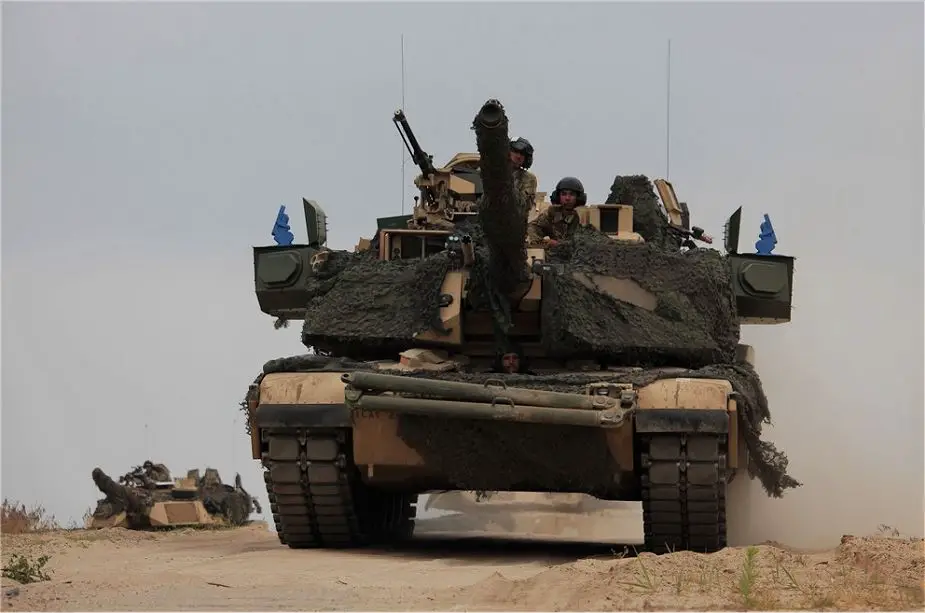U.S. Soldiers assigned to Company D, 1st Squadron, 1st Cavalry Regiment, 2nd Armored Brigade Combat Team, 1st Armored Division, tested the Trophy Active Protection System mounted on M1A2 SEPv2 Abrams Main Battle Tank (MBT) at Fort Bliss Dec. 1-13, 2018, that engages threats in the air.

A picture was released on Internet showing an M1A2 Abrams SEP V2 equipped with the Trophy APS Active Protection System during military exercise Saber Strike 2018 (Picture source Internet)
“Pretty much what it does is it engages the threat before it hits the tank,” said Lt. Col. James Edwards, test officer with the Army Evaluation Center, Army Test and Evaluation Command, Aberdeen Proving Ground, Maryland. “We’re trying to determine whether or not this capability will be applicable to the Abrams (tank) platform.” To do this, testers had Soldiers assigned to Co. D, 1st Sqdn., 1st Cav. Regt., execute tank gunnery Tables III through VI. They used live rounds at Table VI, on both regular M1A2 SEPv2 Abrams Main Battle Tanks (MBTs) and then with tanks outfitted with the Trophy system, Edwards said.
The testing culminated with a simulated threat shot near, but not directly at, a tank, to see if the system would engage the threat, Edwards said. Civilians, not Soldiers, were in the tank during the testing.
The Israeli government first developed the Trophy technology, and the U.S. Army began developing the system for the Abrams about two years ago. Production of the system would be collaboration between General Dynamics Land Systems, Leonardo DRS and Rafael Advanced Defense Systems Ltd.
The Trophy is an APS (Active Protection System) for tanks and combat vehicles developed and designed by the Israeli Company Rafael. The goal of this APS is to intercept and destroy incoming missiles and rockets with a shotgun-like blast.
The Rafael Trophy consists of Elta EL/M-2133 F/G band fire-control radar with four flat-panel antennas mounted on the vehicle, with a 360-degree field of view. When a projectile is detected, the internal computer calculates an approach vector almost instantly, before it arrives. Once the incoming weapon is fully classified, the computers calculate the optimal time and angle to fire the neutralizers. The response comes from two rotating launchers installed on the sides of the vehicle which fire neutralizing agents, usually small metal pellets like buckshot. The system is designed to have a very small kill zone, so as not to endanger personnel adjacent to the protected vehicle.
The Trophy is able to intercept all types of anti-tank missiles and rockets, including handheld weapons such as rocket propelled grenades. The system can simultaneously engage several threats arriving from different directions, is effective on stationary or moving platforms, and is effective against both short- and long-range threats. Newer versions of the system include a reloading feature for multiple firings. The Trophy development plan includes an enhanced countermeasures unit to be available in the future for protection against kinetic energy penetrators.
The M1A2 SEP V2 is an improvement of the M1A2 SEP main battle tank. Upgrades include improved survivability, automotive power pack, computer systems, and night vision capabilities. As the second version in the M1A2 SEP, the V2 variant provides the Army with a digital tank with a new electronic backbone, powerful new computers and an open architecture designed to accept future technologies without the need for significant redesign.
The main armament of the M1A2 SEP V2 MBT is similar to the M1A2 Abrams which consists of one 120 mm smoothbore M256 cannon.The standard 12,7mm machine gun for the tank commander is replaced by a Common Remotely Operated Weapon Station (CROWS) II developed by the Norwegian Company Kongsberg Defense armed with a 12.7mm machine gun. The CROWS II is fitted with detached Line of Sight (DLOS) enables the gunner to keep his sights on target, independent of ballistic solution for the weapon/ammo in use.














